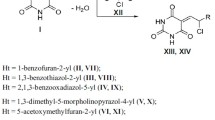Summary
An attempt has been made to explore the little investigated but chemically and biologically interesting group of 2-sulphanilamidothiazolones, mostly carrying lipophilic alkyl radicals in the 5-position, for members likely to prove useful in the treatment of tuberculosis and leprosy. In the synthesis of the candidate compounds, emphasis has been laid on the N4-n-fatty acyl derivatives of 2-sulphanilamido-5-substituted thiazolones in the expectation that these would be even more lipophilic than the free sulphanilamidothiazolones themselves.
A preparative method for the intermediate 2-amino-5-substituted thiazolones, starting with the corresponding mono- and dibasic fatty acids, has been worked out. New 5-substituted pseudothiohydantoins, derived from monobasic acids, are 5-iso propyl-, 5-n-hexyl-, 5-n-tetradecyl-, and 5-phenyl-2-amino-thiazolones. Among new 5∶5′-alkylene-bis-pseudothiohydantoins are 5∶5′-ethylene-bis-2∶2′-aminothiazolone and 5∶5′-hexamethylene-bis-2∶2′-aminothiazolone, prepared from adipic and sebacic acids respectively.
The following sulphonamidothiazolones have been synthesised: N4-n-butyryl-, N4-n-valeryl-, and the N4-n-caproyl sulphanilyl derivatives of 2-amino-, 2-amino-5-methyl- 2-amino-5-ethyl-, 2-amino-5-isopropyl-, 2-amino-5-n-hexyl-, and 2-amino-5-phenyl-thiazolones; andbis-N4-n-butyryl,bis-N4-n-valeryl- andbis-N4-n-caproyl-sulphanilyl derivatives of 5∶5′-ethylene-bis-2-amino and 5∶5′-hexamethylene-bis-2-aminothiazolones.
2-Sulphanilamido-5-ethylthiazolone, prepared in the course of this study, differs in its physical characteristics from that of sulphaethylthiazolone as reported by the earlier workers. However, the present sample affords good analytical values and is markedly active in some acute bacterial infections.
Similar content being viewed by others
References
Moore and MillerJ. Amer. Chem. Soc., 1941,64, 2343.
Cooper, Gross and LewisProc. Soc. Exp. Bio. Med., 1941,47, 538.
Chemotherapy Group of the Haffkine Insitute Unpublished work.
Author information
Authors and Affiliations
Additional information
(Communicated by Major-General Sir S. S. Sokhey,kt, f.a.sc.)
Rights and permissions
About this article
Cite this article
Deliwala, C.V., Rajagopalan, S. Chemotherapy of Tuberculosis. Proc. Indian Acad. Sci. (Math. Sci.) 31, 26–30 (1950). https://doi.org/10.1007/BF03049216
Received:
Issue Date:
DOI: https://doi.org/10.1007/BF03049216




